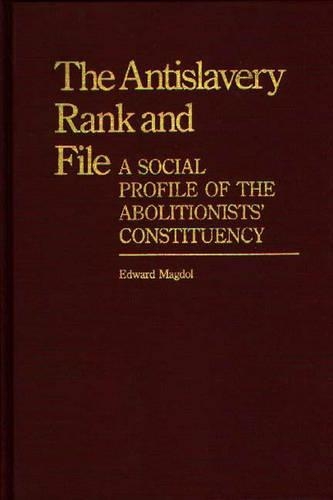
The Antislavery Rank and File: A Social Profile of the Abolitionists' Constituency
(Hardback)
Publishing Details
The Antislavery Rank and File: A Social Profile of the Abolitionists' Constituency
Bloomsbury Publishing PLC
Praeger Publishers Inc
17th September 1986
United States
Classifications
Tertiary Education
Non Fiction
Slavery, enslaved persons and abolition of slavery
322.440973
Physical Properties
Hardback
188
Reviews
Magdol, author of earlier studies of Owen Lovejoy (1967) and the freedmen's community (1977), died shortly before the completion of this study, which was readied for publication by his widow and a friend-colleague. Four chapters provide background. Four others analyze northeasterners (from selected communities) who joined antislavery societies or signed antislavery petitions during the 1830s, or who supported anti-Kansas-Nebraska Act petitions during 1854. These group studies shed light on the social and economic characteristics of the antislavery rank and file. In one instance, their partisan affiliations are illuminated as well, though the communities from which they sprang are not always evaluated. A final chapter offers the author's conclusions. One of the two appendixes deals with scholarship on antislavery supporters, the other with Magdol's methods. Such is the balance between the gnernal and the specific in this book that it will most likely appeal to upper-division undergraduates and graduate students.-Choice
"Magdol, author of earlier studies of Owen Lovejoy (1967) and the freedmen's community (1977), died shortly before the completion of this study, which was readied for publication by his widow and a friend-colleague. Four chapters provide background. Four others analyze northeasterners (from selected communities) who joined antislavery societies or signed antislavery petitions during the 1830s, or who supported anti-Kansas-Nebraska Act petitions during 1854. These group studies shed light on the social and economic characteristics of the antislavery rank and file. In one instance, their partisan affiliations are illuminated as well, though the communities from which they sprang are not always evaluated. A final chapter offers the author's conclusions. One of the two appendixes deals with scholarship on antislavery supporters, the other with Magdol's methods. Such is the balance between the gnernal and the specific in this book that it will most likely appeal to upper-division undergraduates and graduate students."-Choice
Author Bio
gdol /f Edward
